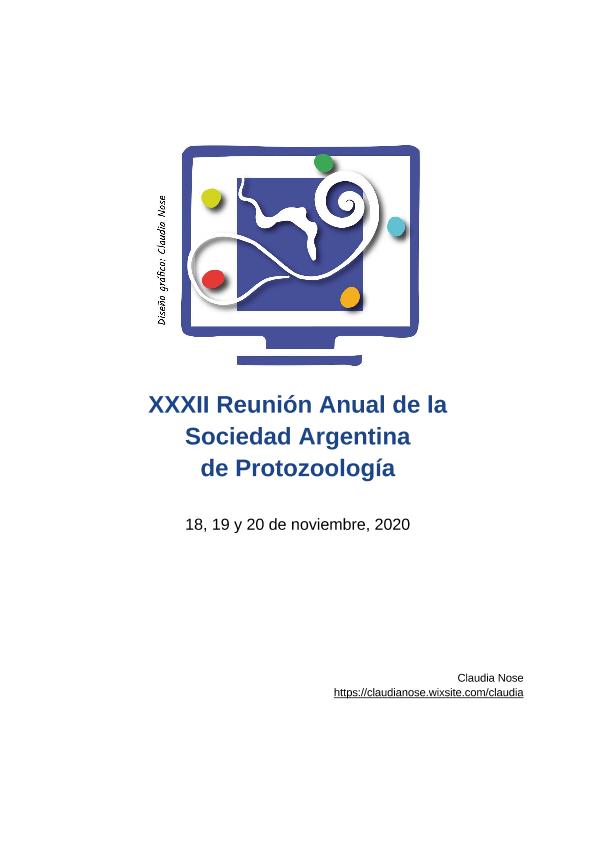Mostrar el registro sencillo del ítem
dc.contributor.author
Ossowski, Micaela Soledad

dc.contributor.author
Gallardo, Juan Pablo
dc.contributor.author
Niborski, Leticia Laura

dc.contributor.author
Mariño, Karina Valeria

dc.contributor.author
Santos, Javier

dc.contributor.author
Potenza, Mariana

dc.contributor.author
Gomez, Karina Andrea

dc.contributor.other
Riarte, Adelina Rosa

dc.contributor.other
Longhi, Silvia Andrea

dc.contributor.other
Frank, Fernanda María

dc.date.available
2023-07-03T14:46:56Z
dc.date.issued
2020
dc.identifier.citation
In silico and molecular characterization of Q4D1D9_TRYCC, a novel high-molecular weight antigen from Trypanosoma cruzi; XXXII Reunión Anual de la Sociedad Argentina de Protozoología; Ciudad Autónoma de Buenos Aires; Argentina; 2020; 38-38
dc.identifier.uri
http://hdl.handle.net/11336/202026
dc.description.abstract
Chagas illness, a potentially life-threatening disease, is an infection caused by thehemoflagellate parasite Trypanosoma cruzi. By phage display technology, involving cDNAisolated from B cells of patients with chronic Chagas disease (CCC), we selected arecombinant monoclonal antibody, named scFv 6B6, which recognized a protein of ~300kDa only expressed in T. cruzi. Although preliminary, data showed that only plasma frompatients with CCC but not those from with Leishmaniasis or non-infected subjects reactedagainst 6B6 antigen. In this work, immunoprecipitation coupled to mass spectrometryrevealed that 6B6 antigen was a hypothetical protein of 323 kDa, named Q4D1D9_TRYCC.According to phylogenetic analysis, this protein is highly conserved throughout evolution inall linages of T. cruzi so far identified but lacks orthologues in other kinetoplastid parasites.In parallel, bioinformatic approaches established that this protein has the most commonlypost-translational modifications (acetylation, glycosylation, among others) identified in T.cruzi and the B cell epitopes predictors mapped that almost the entirely protein sequence isimmunogenic. Structural predictions using RaptorX server allowed us to foretell six structuraldomains of Q4D1D9_TRYCC. Interestingly, we found that this protein presentspyrroloquinoline quinone-dependent alcohol dehydrogenase (PQQ) domains, an enzymefunction that has not been yet documented in Trypanosomatids. We hypothesize that theenzymatic activity of Q4D1D9_TRYCC may be involved in some detoxification processexerted by the parasite during the mammalian host invasion. To date, our finding allowed theidentification of a novel T. cruzi protein as a promising diagnostic candidate for Chagasdisease. Moreover, the inhibition of its enzymatic activity could be tested for thedevelopment of new drugs against T. cruzi.
dc.format
application/pdf
dc.language.iso
spa
dc.publisher
Sociedad Argentina de Protozoología
dc.rights
info:eu-repo/semantics/openAccess
dc.rights.uri
https://creativecommons.org/licenses/by-nc-sa/2.5/ar/
dc.subject
TRYPANOSOMA CRUZI
dc.subject
DIAGNOSTICO
dc.subject
PIRROLOQUINOLINA QUINONA
dc.subject
ENFERMEDAD DE CHAGAS
dc.subject.classification
Bioquímica y Biología Molecular

dc.subject.classification
Ciencias Biológicas

dc.subject.classification
CIENCIAS NATURALES Y EXACTAS

dc.title
In silico and molecular characterization of Q4D1D9_TRYCC, a novel high-molecular weight antigen from Trypanosoma cruzi
dc.type
info:eu-repo/semantics/publishedVersion
dc.type
info:eu-repo/semantics/conferenceObject
dc.type
info:ar-repo/semantics/documento de conferencia
dc.date.updated
2022-11-09T18:34:32Z
dc.journal.pagination
38-38
dc.journal.pais
Argentina

dc.journal.ciudad
Ciudad Autónoma de Buenos Aires
dc.description.fil
Fil: Ossowski, Micaela Soledad. Consejo Nacional de Investigaciones Científicas y Técnicas. Instituto de Investigaciones en Ingeniería Genética y Biología Molecular "Dr. Héctor N. Torres"; Argentina
dc.description.fil
Fil: Gallardo, Juan Pablo. Consejo Nacional de Investigaciones Científicas y Técnicas. Instituto de Investigaciones en Ingeniería Genética y Biología Molecular "Dr. Héctor N. Torres"; Argentina
dc.description.fil
Fil: Niborski, Leticia Laura. Institute Curie; Francia. Consejo Nacional de Investigaciones Científicas y Técnicas. Instituto de Investigaciones en Ingeniería Genética y Biología Molecular "Dr. Héctor N. Torres"; Argentina
dc.description.fil
Fil: Mariño, Karina Valeria. Consejo Nacional de Investigaciones Científicas y Técnicas. Instituto de Biología y Medicina Experimental. Fundación de Instituto de Biología y Medicina Experimental. Instituto de Biología y Medicina Experimental; Argentina
dc.description.fil
Fil: Santos, Javier. Universidad de Buenos Aires. Facultad de Ciencias Exactas y Naturales. Instituto de Biociencias, Biotecnología y Biología Traslacional.; Argentina. Consejo Nacional de Investigaciones Científicas y Técnicas; Argentina
dc.description.fil
Fil: Potenza, Mariana. Consejo Nacional de Investigaciones Científicas y Técnicas. Instituto de Investigaciones en Ingeniería Genética y Biología Molecular "Dr. Héctor N. Torres"; Argentina
dc.description.fil
Fil: Gomez, Karina Andrea. Consejo Nacional de Investigaciones Científicas y Técnicas. Instituto de Investigaciones en Ingeniería Genética y Biología Molecular "Dr. Héctor N. Torres"; Argentina
dc.relation.alternativeid
info:eu-repo/semantics/altIdentifier/url/https://protozoologia.org.ar/wp-content/uploads/Libro-de-Resumenes-SAP-2020.pdf
dc.conicet.rol
Autor

dc.conicet.rol
Autor

dc.conicet.rol
Autor

dc.conicet.rol
Autor

dc.conicet.rol
Autor

dc.conicet.rol
Autor

dc.conicet.rol
Autor

dc.coverage
Nacional
dc.type.subtype
Reunión
dc.description.nombreEvento
XXXII Reunión Anual de la Sociedad Argentina de Protozoología
dc.date.evento
2020-11-18
dc.description.ciudadEvento
Ciudad Autónoma de Buenos Aires
dc.description.paisEvento
Argentina

dc.type.publicacion
Book
dc.description.institucionOrganizadora
Sociedad Argentina de Protozoologia
dc.source.libro
Libro de resúmenes de la XXXII Reunión Anual de la Sociedad Argentina de Protozoología
dc.date.eventoHasta
2020-11-20
dc.type
Reunión
Archivos asociados
